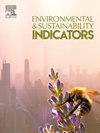Understanding farmers' land use behaviour is a prerequisite for designing effective policies that aim to protect and enhance biodiversity in agriculture. We develop a typology of Swiss farmers' land use patterns in terms of their agricultural production and biodiversity conservation. We contribute by adopting a comprehensive perspective encompassing not only EFAs (Ecological Focus Areas) but also non-EFAs. Relying on a sample of 2341 Swiss farm observations from the Farm Agri-Environmental and the Farm Accountancy Data Network, we conducted – for each agricultural region (plain, hill and mountain) – a K-means clustering to identify farmland use patterns. We considered four clustering variables, namely agricultural production intensity, the extent of a farm's participation in agri-environmental payment schemes and the impact of farm agricultural practices on the organismal biodiversity of 1) EFAs and 2) non-EFAs. The analysis reveals four distinct farmland use patterns beyond the classical dichotomy of low shares of EFAs and high agricultural production intensity versus high shares of EFAs and low agricultural production intensity. Three of the four land use patterns are similar across all agricultural regions. Our findings show that biodiversity enhancement is possible outside of EFA direct payment programmes. One cluster succeeded in exhibiting both a high agricultural production intensity and a high overall biodiversity score, which highlights that these dimensions are not mutually exclusive. The low or moderate use intensity of mineral fertilisers, pesticides and purchased feedstuffs in combination with a high use efficiency of these inputs seems to be the key to reconciling agricultural production and biodiversity conservation.


